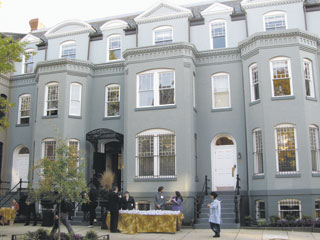|
Date: Nov 17, 2009 From: Indian Country Today Tribal embassy opens to great fanfare |
|
 WASHINGTON
– The week of the White House Tribal
Nations Conference was one of many high notes, including strong
promises from the president and his administration, unprecedented
representation from tribal leadership, and the festive opening of an
international Embassy of Tribal Nations. WASHINGTON
– The week of the White House Tribal
Nations Conference was one of many high notes, including strong
promises from the president and his administration, unprecedented
representation from tribal leadership, and the festive opening of an
international Embassy of Tribal Nations.
The Nov. 3 kickoff of the tribal embassy, located at 1514 P St., N.W. in the heart of the nation’s capital, embodied the climax of years of planning by the National Congress of American Indians to enhance the presence of tribal sovereign nations. The address of the large grey building is in the Dupont Circle area near Embassy Row, where many foreign embassies and diplomatic facilities have their homes. “It’s a glorious time,” said W. Ron Allen, an NCAI board member and chairman of the Jamestown S’Klallam Tribe. “I’m pretty happy.” Establishing the embassy has been one of Allen’s top priorities during the several years he’s served with NCAI. Ideas for the embassy were spawned in the 1980s, he said, and donations from tribes started being seriously collected in the 2000s. “It’s been my baby for so long, and it will continue to be until it’s totally paid off.” NCAI leaders spent a chunk of late-winter and spring sealing the deal on the 17,000-square-foot office building with an 8,500-square-foot lot. It was listed for sale at $8.5 million. Research from the organization’s planners indicated it was a good time to buy, especially considering the dip in prices in the real estate market and the high cost of rent in the region. They hope the investment will increase the value and long-term equity and stability of the organization’s assets. Hundreds of tribal citizens gathered at the facility on launch day, taking turns touring the main building and participating in a day-long ceremony devoted to its dedication. In the morning, approximately 70 tribal leaders gathered for a prayer and blessing event. Later, traditional food and drink was served, and many in attendance heralded the opening of the embassy. “It’s a new time, it’s a new era,” said Ernie Stevens Jr., chairman of the National Indian Gaming Association and citizen of the Oneida Nation of Wisconsin. “We call this Indian country in Washington, D.C. – right here, right now. I think it’s going to make a difference. This is our home.” John Echohawk, the Pawnee director of the Native American Rights Fund, was pleased to see the embassy open, adding that he expects it to be another avenue for tribes to achieve accomplishments in Washington. Billy Frank Jr., chairman of the Northwest Indian Fisheries Commission and citizen of the Nisqually Tribe, remembered taking part in a fire ceremony years ago, which launched the fundraising for the embassy. “All of you helped the fire get bigger and bigger over time, and now look where we are today.” Earlier in the day, hoop, shawl and jingle dancers performed and NCAI president Jefferson Keel, a citizen of the Chickasaw Nation, took part in a Circle Dance. Many in attendance were impressed by the physical features of the building, which include high ceilings, hardwood floors, remodeled baths, two new kitchens and a kitchenette. Much of the space has already been decorated by NCAI staffers with uniquely Indian elements, including tribal paintings, posters and other artwork. NCAI has also reserved a room for tribal leaders who visit Washington and need a place to work. The space features desks with work stations. On the wall is an enlarged picture of several tribal leaders who originally gathered decades ago to help found the organization. Sen Tom Udall, D-N.M., said he believed the embassy would serve to strengthen tribal sovereignty. “Tribal nations now have a permanent place in Washington, D.C. … this is no small thing,” said the senator, who was one of many lawmakers who took part in the opening gala. In total, the facility is made up of three office buildings and three carriage houses. The parking lot, where the dedication festivities were held, has space for 22 vehicles. Beyond NCAI, one of the buildings also now houses the D.C. arm of NARF, as well as the Native American Contractors Association. |
|
|
|
|
